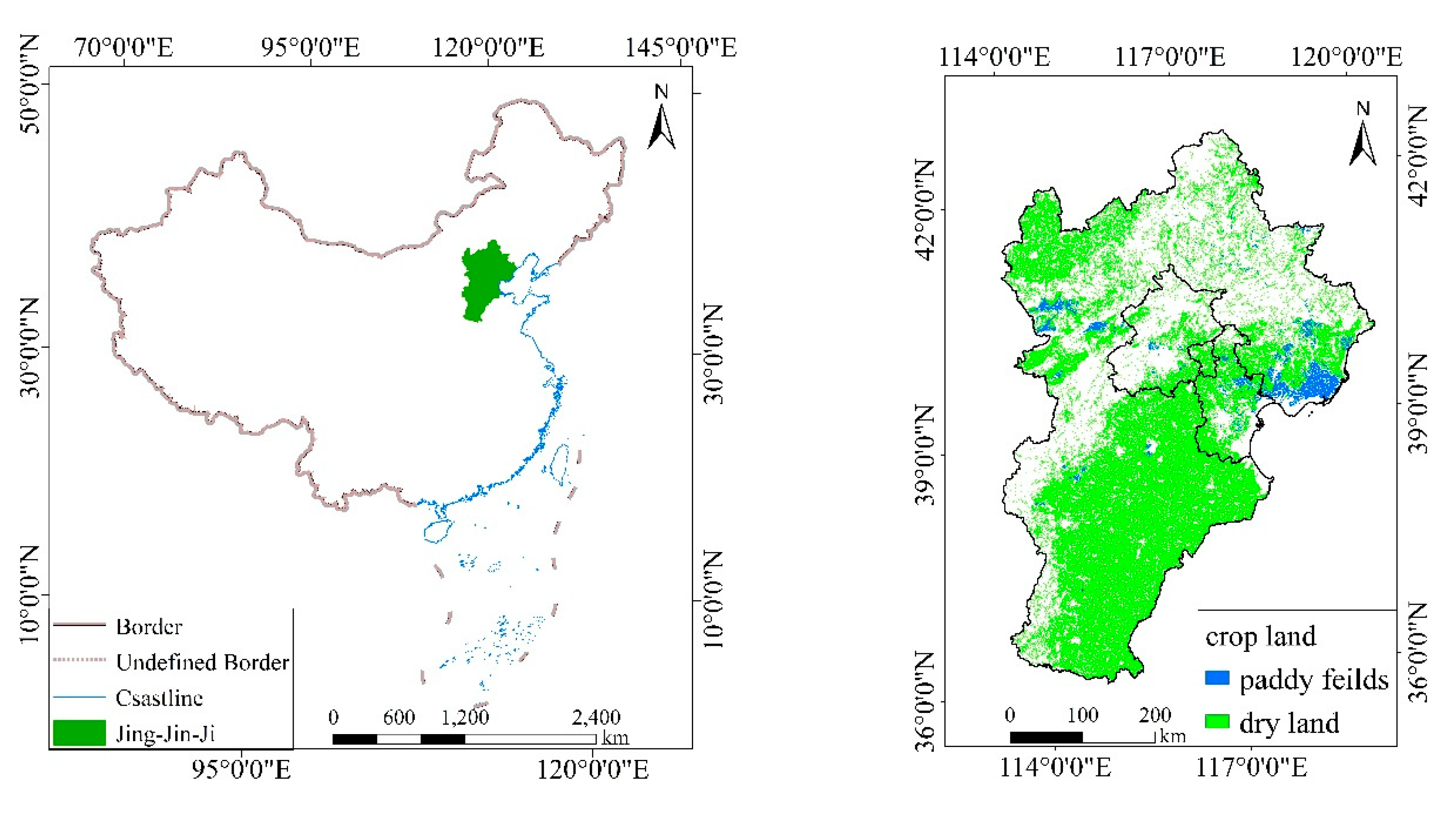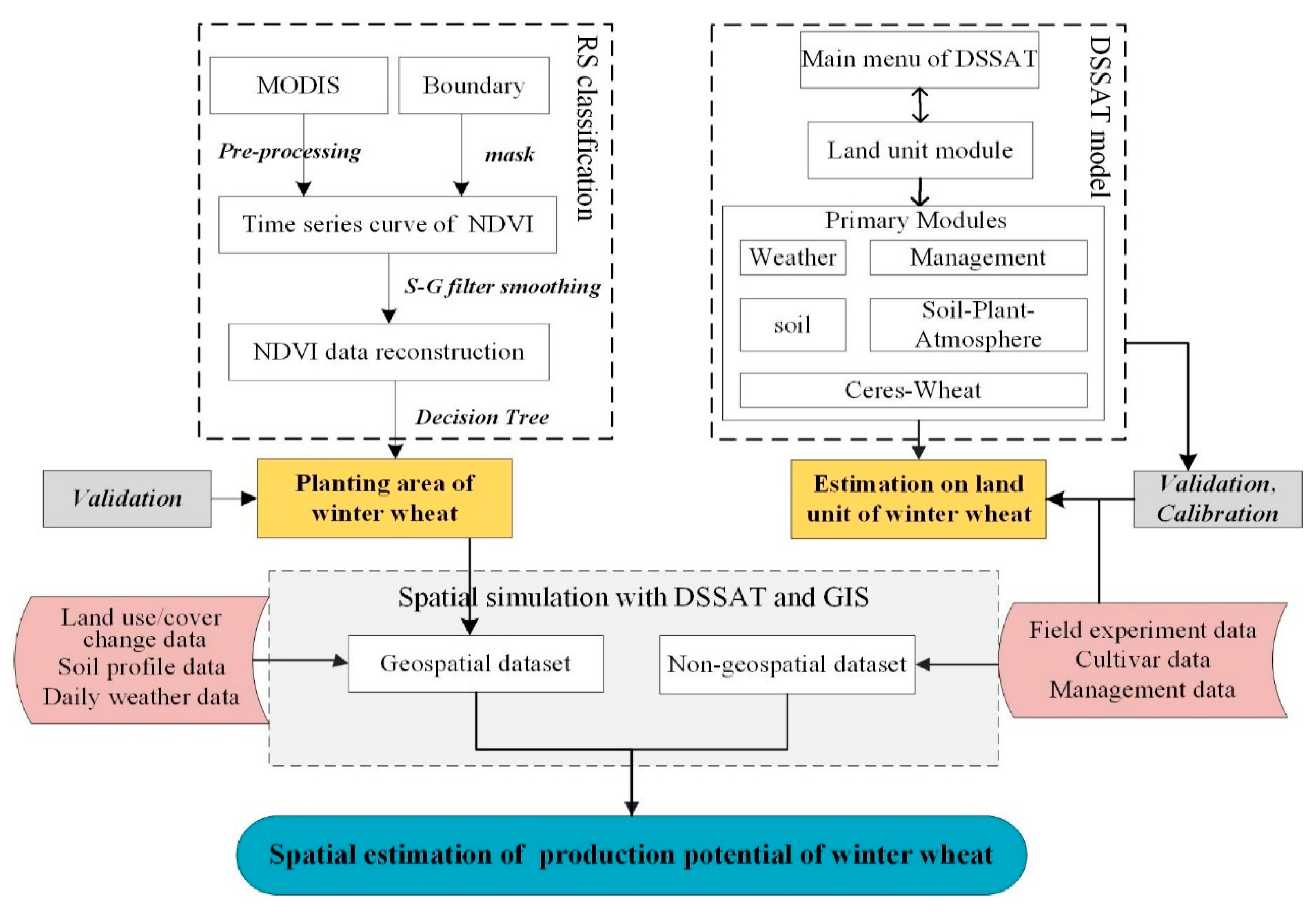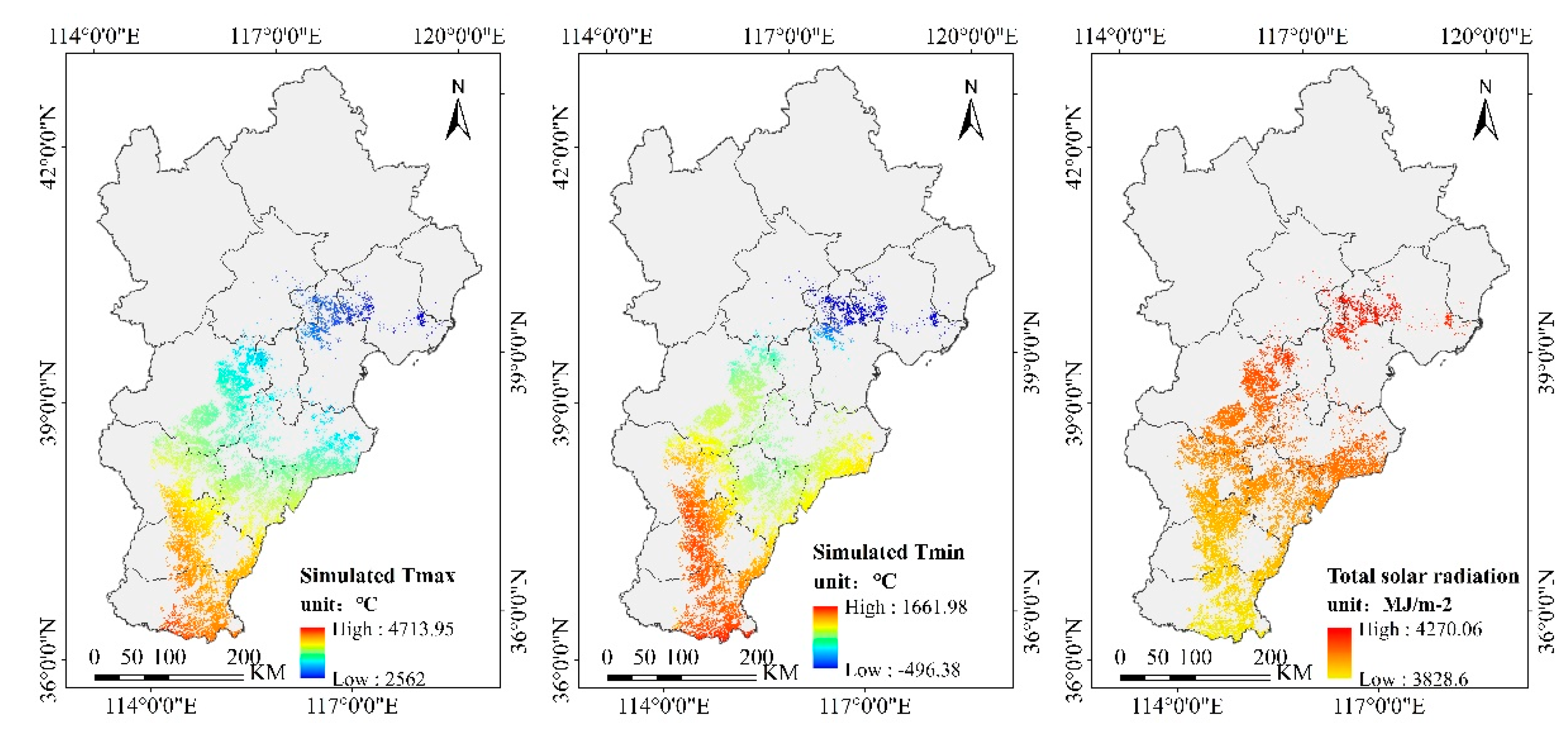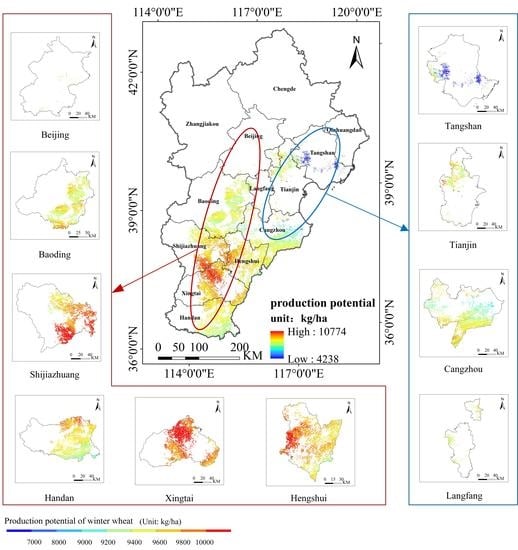Estimation of Winter Wheat Production Potential Based on Remotely-Sensed Imagery and Process-Based Model Simulations
Abstract
1. Introduction
2. Materials and Methods
2.1. Study Area
2.2. Data Collection and Pre-Processing
2.2.1. MODIS Data
2.2.2. Weather Data
2.2.3. Soil Data
2.2.4. Experimental and Crop Management Data
2.3. Production Potential Definition
2.4. Crop Simulation with DSSAT Model and GIS
2.4.1. Extraction of Winter Wheat Planting Area Based on RS
2.4.2. Model Calibration and Validation
2.4.3. Spatial Simulation with DSSAT Model and GIS
3. Results
3.1. Area Validation and Model Validation
3.1.1. Area Validation
3.1.2. Model Validation
3.2. Production Potential of Winter Wheat
4. Discussion
4.1. The Analysis of Production Potential of Winter Wheat Estimation
4.2. Light and Temperature Effects on Production Potential
5. Conclusions
Author Contributions
Funding
Acknowledgments
Conflicts of Interest
References
- Yang, Y.Z.; Zhang, J.; Zhang, P.T. A GIS based study on the potential land productivity and population carrying capacity in Inner Mongolia. J. Arid Land Resour. Environ. 2008, 22, 1–5. [Google Scholar]
- Wart, J.V.; Kersebaum, K.C.; Peng, S.; Milner, M.; Cassman, K.G. Estimating crop yield potential at regional to national scales. Field Crop. Res. 2013, 143, 34–43. [Google Scholar] [CrossRef]
- Merlos, F.A.; Monzon, J.P.; Mercau, J.L.; Taboada, M.; Andrade, F.H.; Hall, A.J.; Jobbagy, E.; Cassman, K.G.; Grassini, P. Potential for crop production increase in Argentina through closure of existing yield gaps. Field Crops Res. 2015, 184, 145–154. [Google Scholar] [CrossRef]
- Feng, Z.M.; Yang, Y.Z.; Yan, H.M.; Pan, T.; Li, P. A review of resources and environment carrying capacity research since the 20th Century: From theory to practice. Resour. Sci. 2017, 39, 379–395. [Google Scholar]
- Huang, J.X.; Jia, S.L.; Ma, H.Y.; Hou, Y.Y.; He, L. Dynamic simulation of growth process of winter wheat in main production areas of China based on WOFOST model. Trans. Chin. Soc. Agric. Eng. 2017, 33, 230–236. [Google Scholar]
- Wang, X.L.; Huang, J.X.; Feng, Q.L.; Yin, D.Q. Winter wheat yield prediction at county level and uncertainty analysis in main Wheat-Producing regions of China with Deep Learning approaches. Remote Sens. 2020, 12, 1744. [Google Scholar] [CrossRef]
- Dong, Q.; Chen, X.H.; Chen, J.; Zhang, C.S.; Liu, L.C.; Cao, X.; Zang, Y.Z.; Zhu, X.F.; Cui, X.H. Mapping winter wheat in North China using Sentinel 2A/B data: A method based on Phenology-Time Weighted Dynamic Time Warping. Remote Sens. 2020, 12, 1274. [Google Scholar] [CrossRef]
- Dai, D.; Sun, M.; Xu, X.; Lei, K. Assessment of the water resource carrying capacity based on the ecological footprint: A case study in Zhangjiakou City, North China. Environ. Sci. Pollut. Res. 2019, 26, 11000–11011. [Google Scholar] [CrossRef]
- Deng, X.Z.; Gibson, J.; Wang, P. Relationship between landscape diversity and crop production: A case study in the Hebei Province of China based on multi-source data integration. J. Clean. Prod. 2017, 142, 985–992. [Google Scholar] [CrossRef]
- Brown, R.A.; Rosenberg, N.J. Climate change impacts on the potential productivity of corn and winter wheat in their primary United States growing regions. Clim. Chang. 1999, 41, 73–107. [Google Scholar] [CrossRef]
- Mkhabela, M.S.; Bullock, P.; Raj, S.; Wang, S.; Yang, Y. Crop yield forecasting on the Canadian Prairies using MODIS NDVI data. Agric. For. Meteorol. 2011, 151, 385–393. [Google Scholar] [CrossRef]
- Sun, H.; Xu, A.; Lin, H.; Zhang, L.; Mei, Y. Winter wheat mapping using temporal signatures of MODIS vegetation index data. Int. J. Remote Sens. 2012, 33, 5026–5042. [Google Scholar] [CrossRef]
- Xu, X.; Conrad, C.; Doktor, D. Optimising phenological metrics extraction for different crop types in Germany using the Moderate Resolution Imaging Spectrometer (MODIS). Remote Sens. 2017, 9, 254. [Google Scholar] [CrossRef]
- Lollato, R.P.; Edwards, J.T.; Ochsner, T.E. Meteorological limits to winter wheat productivity in the U.S. southern Great Plains. Field Crops Res. 2017, 203, 212–226. [Google Scholar] [CrossRef]
- HU, Q.; Wu, W.B.; Song, X.; Yu, Q.Y.; Yang, P.; Tang, H.J. Recent progresses in research of crop patterns mapping by using Remote Sensing. Sci. Agric. Sin. 2015, 10, 34–48. [Google Scholar]
- Sonobe, R. Combining ASNARO-2 XSAR HH and Sentinel-1 C-SAR VH/VV Polarization Data for Improved Crop Mapping. Remote Sens. 2019, 11, 1920. [Google Scholar] [CrossRef]
- Meng, S.; Zhong, Y.; Luo, C.; Hu, X.; Wang, X.; Huang, S. Optimal Temporal Window Selection for Winter Wheat and Rapeseed Mapping with Sentinel-2 Images: A Case Study of Zhongxiang in China. Remote Sens. 2020, 12, 226. [Google Scholar] [CrossRef]
- Wang, L.; Zhai, Y.X.; Wang, F. Development of Theory and Application in Agriculture of GIS. J. Agro-Environ. Sci. 2005, 24, 362–366. [Google Scholar]
- Rohit, S.; Sachin, S.K.; Angappa, G. Big GIS analytics framework for agriculture supply chains: A literature review identifying the current trends and future perspectives. Comput. Electron. Agric. 2018, 155, 103–120. [Google Scholar]
- Thakkar, A.K.; Desai, V.R.; Patel, A.; Potdar, M.B. Post-classification corrections in improving the classification of Land Use/Land Cover of arid region using RS and GIS: The case of Arjuni watershed, Gujarat, India. Egypt. J. Remote Sens. Space Sci. 2017, 20, 79–89. [Google Scholar] [CrossRef]
- Jones, J.W.; Hoogenboom, G.; Porter, C.H.; Boote, K.J.; Batchelor, W.D.; Hunt, L.A.; Wilkens, P.W.; Singh, U.; Gijsman, A.J.; Ritchie, J.T. The DSSAT cropping system model. Eur. J. Agron. 2003, 18, 235–265. [Google Scholar] [CrossRef]
- Negm, L.M.; Youssef, M.A.; Skaggs, R.W.; Chescheir, G.M.; Jones, J. DRAINMOD–DSSAT model for simulating hydrology, soil carbon and nitrogen dynamics, and crop growth for drained crop land. Agric. Water Manag. 2014, 137, 30–45. [Google Scholar] [CrossRef]
- Boote, K.J.; Prasad, V.; Allen, L.H.; Singh, P.; Jones, J.W. Modeling sensitivity of grain yield to elevated temperature in the DSSAT crop models for peanut, soybean, dry bean, chickpea, sorghum, and millet. Eur. J. Agron. 2018, 100, 99–109. [Google Scholar] [CrossRef]
- Rezzoug, W.; Gabrielle, B.; Suleiman, A.; Benabdeli, K. Application and evaluation of the DSSAT-wheat in the Tiaret region of Algeria. Afr. J Agric. Res. 2008, 3, 284–296. [Google Scholar]
- Liu, H.L.; Yang, J.Y.; Drury, C.F.; Reynolds, W.D.; Tan, C.S.; Bai, Y.L.; He, P.; Jin, J.; Hoogenboom, G. Using the DSSAT-CERES-Maize model to simulate crop yield and nitrogen cycling in fields under long-term continuous maize production. Nutr. Cycl. Agroecosys. 2011, 89, 313–328. [Google Scholar] [CrossRef]
- Araya, A.; Kisekka, I.; Gowda, P.H.; Prasad, P.V.V. Evaluation of water-limited cropping systems in a semi-arid climate using DSSAT-CSM. Agric. Syst. 2017, 150, 86–98. [Google Scholar] [CrossRef]
- Priya, S.; Shibasaki, R. National spatial crop yield simulation using GIS-based crop production model. Ecol. Model. 2001, 136, 113–129. [Google Scholar] [CrossRef]
- Shi, X.Y.; Tang, L.; Liu, X.J.; Cao, W.X.; Zhu, Y. Predicting spatial productivity in wheat based on model and GIS. Sci. Agric. Sin. 2009, 42, 3828–3835. [Google Scholar]
- Kadiyala, M.D.M.; Nedumaran, S.; Singh, P.; Chukka, S.; Irshad, M.A.; Bantilan, M.C.S. An integrated crop model and GIS decision support system for assisting agronomic decision making under climate change. Sci. Total Environ. 2015, 521–522, 123–134. [Google Scholar] [CrossRef]
- Lv, Z.; Liu, X.; Cao, W.; Zhu, Y. A model-based estimate of regional wheat yield gaps and water use efficiency in main winter wheat production regions of China. Sci. Rep. 2017, 7, 1–15. [Google Scholar] [CrossRef]
- Wardlow, B.D.; Egbert, S.L. Large-area crop mapping using time-series MODIS 250 m NDVI data: An assessment for the U.S. Central Great Plains. Remote Sens. Environ. 2008, 112, 1096–1116. [Google Scholar] [CrossRef]
- Skakun, S.; Franch, B.; Vermote, E.; Roger, J.C.; Beckerreshef, I.; Justice, C.; Kussul, N. Early season large-area winter crop mapping using MODIS NDVI data, growing degree days Information and a Gaussian Mixture Model. Remote Sens. Environ. 2017, 195, 244–258. [Google Scholar] [CrossRef]
- Mavromatis, T. Estimation of solar radiation and its application to crop simulation models in Greece. Clim. Res. 2008, 36, 219–230. [Google Scholar] [CrossRef]
- Zhang, X.; Shao, J.A.; Luo, H. Spatial interpolation of air temperature with ANUSPLIN in Three Gorges Reservoir Area. In Proceedings of the International Conference on Remote Sensing, Nanjing, China, 24–26 June 2011; IEEE: Los Alamitos, CA, USA, 2011. [Google Scholar]
- Evans, L.T.; Fischer, R.A. Yield potential: Its definition, measurement and significance. Crop Sci. 1999, 39, 1544–1551. [Google Scholar] [CrossRef]
- Wang, T.; Lv, C.H.; Yu, B.H. Assessing the potential productivity of winter wheat using WOFOST in the Beijing-Tianjin-Hebei region. J. Nat. Resour. 2010, 25, 475–487. [Google Scholar]
- Qiu, D.C. Land Resources Science; Southwest China Normal University Press: Chongqing, China, 2005; pp. 132–154. [Google Scholar]
- Chang, Q.R. Land Resources Science; Northwest A&F University Press: Xianyang, China, 2002; pp. 153–159. [Google Scholar]
- Zhang, J.J.; Miao, J.F. Effects of climate change on light and temperature conditions of agricultural production in China. Chin. J. Agrometeorol. 1993, 14, 11–16. [Google Scholar]
- Vintrou, E.; Desbrosse, A.; Bégué, A.; Traoré, S.; Baron, C.; Seen, D.L. Crop area mapping in West Africa using landscape stratification of MODIS time series and comparison with existing global land products. Int. J. Appl. Earth Obs. 2012, 14, 83–93. [Google Scholar] [CrossRef]
- Rimal, B.; Zhang, L.; Rijal, S. Crop cycles and crop land classification in Nepal using MODIS NDVI. Remote Sens. Earth Syst. Sci. 2018, 1, 14–28. [Google Scholar] [CrossRef]
- Pan, Z.; Huang, J.; Zhou, Q.; Wang, L.; Cheng, Y.; Zhang, H.; Blackburn, G.A.; Jing, Y.; Liu, J. Mapping crop phenology using NDVI time-series derived from HJ-1 A/B data. Int. J. Appl. Earth Obs. 2015, 34, 188–197. [Google Scholar] [CrossRef]
- Chen, J.; Jönsson, P.; Tamura, M.; Gu, Z.; Matsushita, B.; Eklundh, L. A simple method for reconstructing a high-quality NDVI time-series data set based on the Savitzky–Golay filter. Remote Sens. Environ. 2004, 91, 332–344. [Google Scholar] [CrossRef]
- Liu, J.K.; Zhong, S.Q.; Liang, W.H. Extraction on crops plangting structure based on Multi-temporal Landsat8 OLI images. Remote Sens. Technol. Appl. 2015, 30, 775–783. [Google Scholar]
- Li, Z.; Yang, J.; Drury, C.; Hoogenboom, G. Evaluation of the DSSAT-CSM for simulating yield and soil organic C and N of a long-term maize and wheat rotation experiment in the Loess Plateau of Northwestern China. Agric. Syst. 2015, 135, 90–104. [Google Scholar] [CrossRef]
- Attia, A.; Rajan, N.; Xue, Q.; Nair, S.; Ibrahim, A.; Hays, D. Application of DSSAT-CERES-Wheat model to simulate winter wheat response to irrigation management in the Texas High Plains. Agric. Water Manag. 2016, 165, 50–60. [Google Scholar] [CrossRef]
- Wang, H.; Chen, F.; Shi, Q.H.; Fan, S.C.; Chu, Q.Q. Analysis of factors on impacting potential productivity of winter wheat in Huanghuaihai agricultural area over 30 years. Trans. Chin. Soc. Agric. Eng. 2010, 26, 90–95. [Google Scholar]
- Wu, D.R.; Yu, Q.; Lu, C.; Hengsdijk, H. Quantifying production potentials of winter wheat in the North China Plain. Eur. J. Agron. 2006, 24, 226–235. [Google Scholar] [CrossRef]






| Growth State | Emergence Stage | Overwintering Stage | Green Returned Stage | Erecting Stage | Jointing Stage | Heading Stage | Anthesis Stage | Mature Stage |
|---|---|---|---|---|---|---|---|---|
| Date | 10.5 | 11.30 | 3.11 | 4.10 | 4.23 | 5.13 | 5.17 | 6.20 |
| Dry matter accumulation (g/per plant) | - | 0.5 | 0.3 | 0.4 | 0.7 | - | 2 | 2.8 |
| LAI | - | 3.3 | - | 2.6 | 4.2 | - | 4.6 | - |
| Year | 2014 | 2015 | 2016 |
| Yield (kg/ha) | 5613 | 5826 | 5814 |
| Management Information | Date | Operations |
|---|---|---|
| Planting | 2014.9.28 | Sow in row, 16 cm (row space), 4 cm (seeding depth), 250 kg/hm2 (population) |
| Chemical applications | 2015.3.12 | Herbicide and pesticide |
| Irrigation | 2014.9.29 | Border irrigation, 70 mm |
| 2014.11.9 | Border irrigation, 75 mm | |
| 2015.4.10 | Border irrigation, 80 mm | |
| 2015.5.10 | Border irrigation, 80 mm | |
| Fertilizers | 2014.9.27 | Base fertilizer: urea 220 kg/hm2, diammonium phosphate 300 kg/hm2, potassium nitrate 220 kg/hm2 |
| 2015.4.18 | Additional fertilizer, urea 200 kg/hm2 |
| City | Extracted Area | Area in Statistical Data | Accuracy |
|---|---|---|---|
| Xingtai | 346.92 | 342.87 | 98.83% |
| Tianjin | 96.01 | 101.30 | 94.78% |
| Cangzhou | 361.39 | 382.32 | 94.53% |
| Baoding | 364.81 | 386.16 | 94.47% |
| Handan | 332.11 | 375.39 | 88.47% |
| Shijiazhuang | 276.96 | 319.17 | 86.78% |
| Hengshui | 318.87 | 257.43 | 80.73% |
| Beijing | 7.69 | 11.20 | 68.66% |
| Tangshan | 62.72 | 107.48 | 58.36% |
| Langfang | 37.83 | 66.37 | 57.00% |
| Jing-Jin-Ji | 2205.88 | 2419.20 | 91.18% |
| Parameter | Definition | Value | Unit |
|---|---|---|---|
| P1V | Days required for vernalization, optimum vernalizing temperature | 42.1 | Days |
| P1D | Photoperiod response | 58.9 | % |
| P5 | Grain filling (excluding lag) phase duration | 585 | °C·d |
| PHINT | Interval between successive leaf tip appearances | 105 | °C·d |
| PARUE | PAR conversion to dm ratio, before last leaf stage | 2.5 | g/mJ |
| PARU2 | PAR conversion to dm ratio, after last leaf | 3.42 | g/mJ |
| G1 | Kernel number per unit canopy weight at anthesis | 28 | Kernels/g |
| G2 | Standard kernel size under optimum conditions | 30 | Mg |
| G3 | Standard, non-stressed mature tiller wt (incl. grain) | 1.2 | G |
| LA1S | Area of standard first leaf | 3.1 | cm2 |
| GN%S | Standard grain N | 2.85 | % |
| LAFV | Increase in potential area of leaves, vegetative phase | 0.4 | fr/leaf |
| LAFR | Increase in potential area of leaves, reproductive phase | 1.1 | fr/leaf |
| SLAS | Specific leaf area, standard first leaf | 220 | cm2/g |
| LSPHS | Final leaf senescence starts | 5.0 | Growth stage |
| LSPHE | Final leaf senescence ends | 6.5 | Growth stage |
| Item | Measured Value | Simulated Value | Error/nRMSE |
|---|---|---|---|
| Seeding date (day) | 5 | 6 | 1 day |
| Anthesis date (day) | 229 | 229 | 0 day |
| Harvest (day) | 263 | 262 | 1 day |
| Yield in 2014 (kg/hm2) | 5613 | 5605.7 | 13.02% |
| Yield in 2015 (kg/hm2) | 5826 | 5834.0 | 13.71% |
| Yield in 2016 (kg/hm2) | 5814 | 5821.1 | 12.20% |
| City | The Range of Production Potential | The Average of Production Potential | City | The Range of Production Potential | The Average of Production Potential |
|---|---|---|---|---|---|
| Xingtai | 9064~10,774 | 9848 | Beijing | 6506~9998 | 9390 |
| Shijiazhuang | 8302~10,626 | 9672 | Langfang | 8262~9827 | 9344 |
| Hengshui | 8214~10,328 | 9517 | Tianjin | 5575~9998 | 9223 |
| Baoding | 7999~10,088 | 9433 | Cangzhou | 7999~9937 | 9030 |
| Handan | 8692~10,354 | 9408 | Tangshan | 4238~9516 | 6747 |
| Jing-Jin-Ji | 4238~10,774 | 7865 | - | - | - |
| City | <7000 | 7000~9000 | 9000~10,000 | >10,000 | Total | Percentage (>9000) |
|---|---|---|---|---|---|---|
| Xingtai | 0 | 0 | 41,747 | 13,759 | 55,506 | 100% |
| Shijiazhuang | 0 | 151 | 37,168 | 6994 | 44,313 | 99.66% |
| Hengshui | 0 | 547 | 48,531 | 1940 | 51,018 | 98.93% |
| Baoding | 0 | 1179 | 57,120 | 70 | 58,369 | 97.98% |
| Beijing | 6 | 28 | 1196 | 0 | 1230 | 97.24% |
| Langfang | 0 | 204 | 5849 | 0 | 6053 | 96.63% |
| Tianjin | 81 | 616 | 14,665 | 0 | 15,362 | 95.46% |
| Handan | 0 | 3011 | 49,932 | 194 | 53,137 | 94.33% |
| Cangzhou | 0 | 9572 | 48,250 | 0 | 57,822 | 83.45% |
| Tangshan | 6475 | 533 | 3028 | 0 | 10,036 | 30.17% |
| Jing-Jin-Ji | 6411 | 15,841 | 307,486 | 22,957 | 352,846 | 93.65% |
© 2020 by the authors. Licensee MDPI, Basel, Switzerland. This article is an open access article distributed under the terms and conditions of the Creative Commons Attribution (CC BY) license (http://creativecommons.org/licenses/by/4.0/).
Share and Cite
Lang, T.; Yang, Y.; Jia, K.; Zhang, C.; You, Z.; Liang, Y. Estimation of Winter Wheat Production Potential Based on Remotely-Sensed Imagery and Process-Based Model Simulations. Remote Sens. 2020, 12, 2857. https://doi.org/10.3390/rs12172857
Lang T, Yang Y, Jia K, Zhang C, You Z, Liang Y. Estimation of Winter Wheat Production Potential Based on Remotely-Sensed Imagery and Process-Based Model Simulations. Remote Sensing. 2020; 12(17):2857. https://doi.org/10.3390/rs12172857
Chicago/Turabian StyleLang, Tingting, Yanzhao Yang, Kun Jia, Chao Zhang, Zhen You, and Yubin Liang. 2020. "Estimation of Winter Wheat Production Potential Based on Remotely-Sensed Imagery and Process-Based Model Simulations" Remote Sensing 12, no. 17: 2857. https://doi.org/10.3390/rs12172857
APA StyleLang, T., Yang, Y., Jia, K., Zhang, C., You, Z., & Liang, Y. (2020). Estimation of Winter Wheat Production Potential Based on Remotely-Sensed Imagery and Process-Based Model Simulations. Remote Sensing, 12(17), 2857. https://doi.org/10.3390/rs12172857






